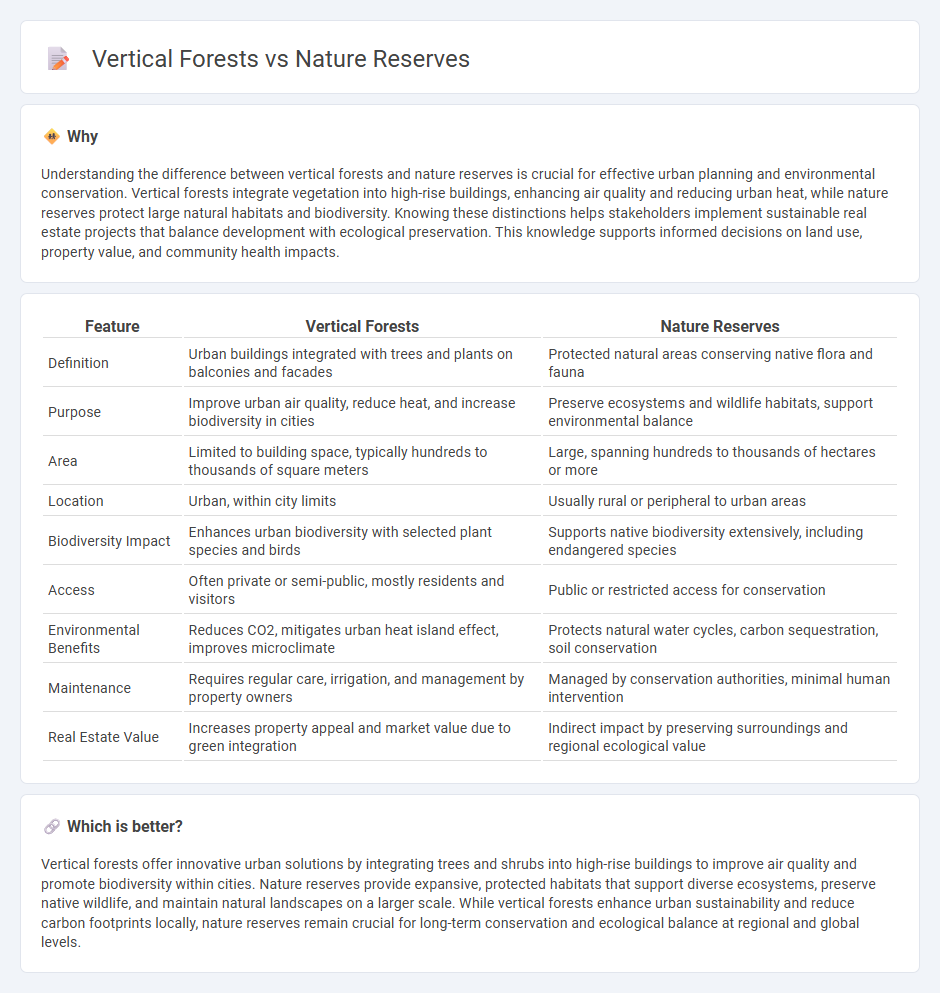
Vertical forests integrate dense vegetation within urban high-rise buildings to enhance air quality and promote biodiversity, contrasting with nature reserves that preserve large, undeveloped natural habitats for wildlife conservation. These innovative architectural designs actively combat urban pollution by providing green spaces in densely populated areas, while nature reserves offer extensive ecosystems crucial for species protection and environmental balance. Explore how vertical forests and nature reserves uniquely contribute to sustainable living and ecological preservation.
Why it is important
Understanding the difference between vertical forests and nature reserves is crucial for effective urban planning and environmental conservation. Vertical forests integrate vegetation into high-rise buildings, enhancing air quality and reducing urban heat, while nature reserves protect large natural habitats and biodiversity. Knowing these distinctions helps stakeholders implement sustainable real estate projects that balance development with ecological preservation. This knowledge supports informed decisions on land use, property value, and community health impacts.
Comparison Table
| Feature | Vertical Forests | Nature Reserves |
|---|---|---|
| Definition | Urban buildings integrated with trees and plants on balconies and facades | Protected natural areas conserving native flora and fauna |
| Purpose | Improve urban air quality, reduce heat, and increase biodiversity in cities | Preserve ecosystems and wildlife habitats, support environmental balance |
| Area | Limited to building space, typically hundreds to thousands of square meters | Large, spanning hundreds to thousands of hectares or more |
| Location | Urban, within city limits | Usually rural or peripheral to urban areas |
| Biodiversity Impact | Enhances urban biodiversity with selected plant species and birds | Supports native biodiversity extensively, including endangered species |
| Access | Often private or semi-public, mostly residents and visitors | Public or restricted access for conservation |
| Environmental Benefits | Reduces CO2, mitigates urban heat island effect, improves microclimate | Protects natural water cycles, carbon sequestration, soil conservation |
| Maintenance | Requires regular care, irrigation, and management by property owners | Managed by conservation authorities, minimal human intervention |
| Real Estate Value | Increases property appeal and market value due to green integration | Indirect impact by preserving surroundings and regional ecological value |
Which is better?
Vertical forests offer innovative urban solutions by integrating trees and shrubs into high-rise buildings to improve air quality and promote biodiversity within cities. Nature reserves provide expansive, protected habitats that support diverse ecosystems, preserve native wildlife, and maintain natural landscapes on a larger scale. While vertical forests enhance urban sustainability and reduce carbon footprints locally, nature reserves remain crucial for long-term conservation and ecological balance at regional and global levels.
Connection
Vertical forests enhance urban biodiversity by integrating dense tree and plant layers on building facades, creating microhabitats that connect to surrounding nature reserves. These green structures serve as ecological corridors, facilitating wildlife movement and supporting native species within metropolitan areas. By mimicking natural ecosystems, vertical forests help mitigate urban heat island effects and improve air quality, complementing the conservation efforts of nearby protected reserves.
Key Terms
Biodiversity
Nature reserves provide expansive habitats supporting diverse flora and fauna, preserving entire ecosystems and genetic variety crucial for biodiversity conservation. Vertical forests integrate greenery into urban architecture, enhancing local biodiversity by creating microhabitats for birds, insects, and plants within city environments. Explore how these biodiversity strategies contribute uniquely to ecological balance and sustainability in different settings.
Land Use
Nature reserves preserve vast ecosystems by maintaining natural habitats that support biodiversity and ecological balance, often spanning hundreds to thousands of hectares. Vertical forests utilize urban land efficiently through high-density tree planting on building facades, enhancing air quality and reducing urban heat islands in limited spaces. Explore how these contrasting land use strategies address environmental sustainability in both rural and urban settings.
Urban Sustainability
Nature reserves preserve biodiversity through large, protected green spaces that support wildlife habitats and ecosystem services, crucial for maintaining urban sustainability. Vertical forests integrate greenery into urban architecture by incorporating trees and plants on building facades, enhancing air quality, reducing urban heat islands, and promoting ecological balance within cities. Explore how these innovative approaches contribute to sustainable urban development and the future of green cities.
Source and External Links
Nature reserve - Wikipedia - A nature reserve is a protected area aimed at conserving wildlife, plants, and their habitats, with notable examples including Nicaragua's 78 protected areas and Russia's approximately 100 zapovedniks covering significant land.
Illinois Nature Preserves - Illinois Nature Preserves protect rare plants, animals, and unique ecosystems, preserving over 11,700 acres of habitats for endangered species managed both publicly and privately under state law.
Nature reserve | Wildlife, Conservation & Preservation | Britannica - Nature reserves are areas set aside primarily for protecting specific plants and animals, often smaller than national parks, with origins dating back to medieval game preserves.
 dowidth.com
dowidth.com